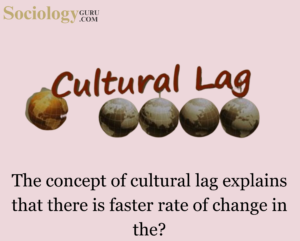Question: The concept of cultural lag explains that there is faster rate of change in the
- Economic sector of society in comparison to non-economic sectors.
- Political domain of society in comparison to economic domain.
- Technological sector of society in comparison to cultural sectors.
- Religious activities of society in comparison to cultural activities.
Answer: (3)
Foundations: Understanding Cultural Lag
“Cultural lag” as a concept is rooted in the observation that different segments of society adapt to changes, particularly technological advancements, at varying paces. Originally coined by sociologist William Fielding Ogburn, it emphasizes the inevitable time lag between the advent of material technological innovations and the adaptation or adjustment of society’s non-material culture, such as beliefs, laws, and general societal norms.
Dissecting the Dynamics: Material vs. Non-Material Culture
At the heart of cultural lag lies the distinction between material and non-material culture. Material culture encompasses the tangible, technological advancements, and physical artifacts that are overtly present and constantly evolving in society. Conversely, non-material culture embodies the intangible aspects, including beliefs, values, symbols, norms, and practices that are deeply ingrained in society’s fabric.
Illustration Through Adaptation: Examples and Implications
Historical and contemporary examples abound illustrating cultural lag. The introduction of automobiles, as mentioned by Ogburn, serves as a potent illustration. The technological advancements in automobiles necessitated a parallel evolution in societal infrastructures, such as roads and traffic regulations. However, there was an inevitable lag in the adaptation of these non-material aspects, reflecting the cultural lag.
Analyzing the Domains: Identifying the Sectors of Change
Returning to the question, the objective is to discern which societal domain exhibits a faster rate of change, leading to cultural lag. The answer emphasizes the technological sector’s rapid advancements compared to the cultural sectors. Technology, being a part of the material culture, exhibits an intrinsic characteristic of rapid evolution and change. However, the cultural sectors, embodying the non-material facets of norms, values, and beliefs, inherently possess a resilience to rapid change, ensuing in a lag in adaptation.
Evaluating the Options: Choosing the Correct Answer
Option (c), “the technological sector of society in comparison to cultural sectors,” resonates most accurately with the underlying principles of cultural lag. It encapsulates the essence of the theory, reflecting the rapid advancements in technology and the slower adaptation processes within cultural norms and values.
Societal Projections: Predictive Value of Cultural Lag
Cultural lag holds immense predictive value. It enables sociologists and policymakers to foresee potential societal challenges, conflicts, or disruptions due to the disparities in adaptation rates between technological advancements and societal norms and values. It thus offers a roadmap to navigate through the potential turbulences caused due to the asynchronous evolution of different societal sectors.
Theoretical Applications: Beyond Technological Determinism
Cultural lag transcends mere technological determinism. While it acknowledges technology’s pivotal role in societal evolution, it doesn’t solely attribute societal changes to technological advancements. Instead, it offers a nuanced perspective, focusing on the adaptation and adjustment periods, and the ensuing social implications and transformations.
Concluding Insights: Synthesizing the Understanding
In conclusion, cultural lag elucidates the nuanced dynamics of societal adaptation to technological and material advancements, emphasizing the disparities in adaptation rates between material and non-material cultural aspects. It fosters a profound understanding of the societal transition phases, potential challenges, and the multifaceted influences of technological advancements on societal norms, values, and structures. Understanding and applying this concept is instrumental in navigating the complex terrains of societal evolution in the face of relentless technological advancements, thus holding a significant place in the analytical explorations in the MA CUET exam and beyond in the realms of sociology and humanities.
Take a Quick Sociology Quiz to measure your Performance
Frequently Asked Questions:
1. Question: Define the term “ethnic movement” and provide an example from India.
Answer: An ethnic movement refers to a collective effort by a group sharing common cultural, linguistic, or religious traits, seeking to assert their identity and rights; an example from India is the Khalistan Movement in Punjab.
2. Question: Identify the main objectives behind the Gorkhaland ethnic movement.
Answer: The Gorkhaland ethnic movement primarily seeks to establish a separate state for India’s Nepali-speaking population in the Darjeeling region, advocating for linguistic and cultural recognition and political autonomy.
3. Question: What was the Operation Blue Star, and which ethnic movement was it related to?
Answer: Operation Blue Star was a military action in 1984, aiming to remove Sikh militants hiding in the Golden Temple in Amritsar; it is related to the Khalistan movement, which sought a separate Sikh country.
4. Question: Mention a critical factor that triggered the emergence of ethnic movements in India, as discussed by Dipankar Gupta.
Answer: Dipankar Gupta emphasized that ethnicity is fundamentally a political process, wherein caste and religion, the key components of identity formation, are politicized by leaders for vested interests.
5. Question: What were the primary reasons for the Assam Ethnicity conflicts involving Bodo tribals and Bengali Muslim settlers?
Answer: The Assam Ethnicity conflicts primarily stemmed from issues related to immigration, land rights, and resource allocation, leading to clashes, riots, and evolving relationships among indigenous communities to address challenges.
6. Question: Briefly describe the role of the Dravidian Movement in terms of caste and societal structure.
Answer: The Dravidian Movement, led notably by E.V. Ramasamy, aimed to establish an egalitarian society, focusing on anti-Brahmanism and advocating for equal rights for backward castes, while also introducing reforms like self-respect marriages.
7. Question: Name the prominent ethnic movements in North-East India and specify one common objective.
Answer: Prominent ethnic movements in North-East India include the Nagas’ and Mizos’ struggles; a common objective was to gain autonomy and recognition for their distinct tribal identities and cultural uniqueness.
8. Question: What is the key argument of Gail Omveldt regarding traditional Indian society and multiculturalism?
Answer: Gail Omveldt opposed romanticizing traditional Indian society, arguing that hierarchy has always dominated it and dismissing the notion that multiculturalism is an intrinsic feature of Indian society as a myth.
9. Question: Briefly explain the social hierarchy factor as a contributing element to ethnic movements as suggested by Olzak.
Answer: Olzak suggests that the construction of hierarchies among ethnic communities, which often leads to the suppression of one group by another, is a key factor that can instigate social and ethnic movements.
10. Question: Identify one consequence of the unequal economic development factor within the context of ethnic movements in India.
Answer: One consequence of unequal economic development is the marginalization and underdevelopment of certain groups, leading to feelings of alienation and sometimes initiating ethnic movements as these groups strive for equality and recognition.
To master these intricacies and fare well in the Sociology Syllabus, aspiring sociologists might benefit from guidance by the Best Sociology Teacher and participation in the Best Sociology Coaching. These avenues provide comprehensive assistance, ensuring a solid understanding of sociology’s diverse methodologies and techniques.
META TAGS:
Why Vikash Ranjan’s Classes for Sociology?
Proper guidance and assistance are required to learn the skill of interlinking current happenings with the conventional topics. VIKASH RANJAN SIR at SOCIOLOGY GURU guides students according to the Recent Trends, making him the Best Sociology Teacher for Sociology.
At Sociology Guru, the Best Sociology Coaching platform, we not only provide the best study material and applied classes for Sociology but also conduct regular assignments and class tests to assess candidates’ writing skills and understanding of the subject.
Choose The Best Sociology Teacher for your Preparation?
To master these intricacies and fare well in the Sociology Syllabus, aspiring sociologists might benefit from guidance by the Best Sociology Teacher and participation in the Best Sociology Coaching. These avenues provide comprehensive assistance, ensuring a solid understanding of sociology’s diverse methodologies and techniques. Sociology, Social theory, Best Sociology Teacher, Best Sociology Coaching, Sociology Syllabus.
Best Sociology Teacher, Sociology Syllabus, Sociology, Sociology Coaching, Best Sociology Coaching, Best Sociology Teacher, Sociology Course, Sociology Teacher, Sociology Foundation, Sociology Foundation Course, Sociology CUET, Sociology for IAS, Sociology for UPSC, Sociology for BPSC, Sociology for UGC NET, Sociology for JPSC,
Follow us :
KEYWORD: – Faster Rate of Change, Faster Rate of Change, Faster Rate of Change, Faster Rate of Change, Faster Rate of Change, Faster Rate of Change, Faster Rate of Change, Faster Rate of Change Sociology, Faster Rate of Change CUET, MA CUET SOCIOLOGY, MA CUET SOCIOLOGY



